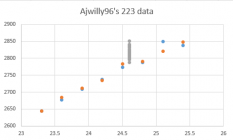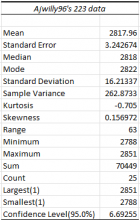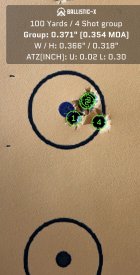Ajwilly96
Gold $$ Contributor
Today I shot a two shot ladder test from my 223 using N140 90gr Berger and CCI-450. These were my charge weights and velocity. I started with a clean barrel and fired five fouling shots.
23.3- 2644,2644
23.6- 2677,2684
23.9- 2708, 2712
24.2- 2738, 2735
24.5- 2774, 2783
24.8- 2788, 2791
25.1- 2849, 2821
25.4- 2838, 2848
Based on these charges and velocities I decided to load 25rds of 24.6gr all the same seating depth. I return and began to fire. Once I was finished. I had velocity ranging from 2788 to 2851.
I was pretty shocked by these results being that the velocity changes were so extreme. Has anyone ever experienced this before? I was not letting my barrel get super hot, it was not a gradual increase in velocity they were pretty sporadic.
I’m not really sure where to go from here.
The grouping at 100 yards is good but I plan to shoot at 1000, so I want to get my velocity under control
23.3- 2644,2644
23.6- 2677,2684
23.9- 2708, 2712
24.2- 2738, 2735
24.5- 2774, 2783
24.8- 2788, 2791
25.1- 2849, 2821
25.4- 2838, 2848
Based on these charges and velocities I decided to load 25rds of 24.6gr all the same seating depth. I return and began to fire. Once I was finished. I had velocity ranging from 2788 to 2851.
I was pretty shocked by these results being that the velocity changes were so extreme. Has anyone ever experienced this before? I was not letting my barrel get super hot, it was not a gradual increase in velocity they were pretty sporadic.
I’m not really sure where to go from here.
The grouping at 100 yards is good but I plan to shoot at 1000, so I want to get my velocity under control















